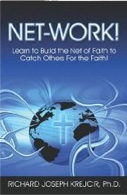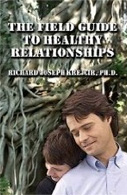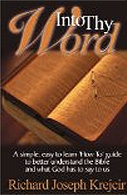The Background of the Gospel According to Matthew
Introductory Thoughts: Twenty or so years after the risen Lord gave the Great Commission, a humble disciple named Levi, who was led by the Spirit, wrote a masterful work without literary parallel. He never quoted himself, or laid a claim on this work. Rather, he lifted up Christ as Lord. How he did it, and what his sources may have been were in debate amongst scholars and theologians for years, but what we have is the prince of the Gospels that conveys the life and blood of the Lamb. It is the book for an understanding of who we are in Christ, what He did, and how we are to live.
The Gospel of Matthew has always occupied a special place of high esteem in the life of the church. From its position as the first book in the New Testament, it is the most read and quoted book in church history. Here is what one "liberal" commentator had to say: When we turn to Matthew, we turn to the book which may well be called the most important single document of the Christian faith, for in it we have the fullest and the most systematic account of the life and the teachings of Jesus. - William Barclay (who has excellent insights, but must be read with much discernment, as he denies miracles, and the Person and work of Christ, as most secular and liberal theologians do.)
Matthew was the most frequently quoted book by the early church (the writings during the first two centuries of the church), and perhaps the most widely read Gospel (or book for that matter) ever! Matthew also occupied the royal seat of theology for the Catholic Church, as they used its imagery to define itself though worship and icons. Then the Reformers called the Church away, not from Matthew, but from the abuse and misrepresentations that accrued. Thus, the focus shifted to Romans as the cradle of theology. Matthew remains as the starting point of faith and knowing the Lord, and the cradle of the Lord.
Why was this Gospel so impacting and popular, and why has it ministered to so many countless hearts over the centuries? Perhaps we can find out why as we venture into the background of and reasons for which it was written.
Authorship: Matthew, whose name means a "gift of the Lord" was also named Levi (surname, Luke 5:27), son of Alphaeus (Mark 2:14), a tax collector (2:14; Luke 5:27), and one whom Jesus met at the tax office (Matt 9:9; Mark 2:14; Luke 5:27). He was then called to be one of Jesus' earliest disciples (Matt. 9:9; 10:2-3; Mark 2:14). Being so close to Jesus during His earthly ministry, Matthew was able to give a first hand account of the life and teachings of Jesus. Matthew was also a highly educated Jew, who made a dramatic conversion from being a cheating tax collector to becoming one of the Twelve!
Early church tradition states that Matthew preached in Palestine for several years while compiling his Gospel in Hebrew then later traveled to Antioch in Syria and wrote a more complete edition in Greek. We find this through the writings of his disciples in the "Early Church Fathers." (See "The Controversies" below.)
How do we know that Matthew wrote the Gospel? (The true Writer is, of course, God! Thus, any book of the Bible is written/inspired through the Holy Spirit, who inspired the human hands. Therefore, when I say Matthew wrote it, I am referring to the human authorship that reflects style, use of language and such, but is still the inerrant Word of God. I am not saying that any book of the Bible was solely written by human hands, only that God used men as His instruments, and worked through language, culture, and time.) Matthew himself records clear and compelling evidence. He was a Jew from Palestine (2:1, 20-21, 3:1, 5, 13, 4:5, 12, 13, 25, 5:35, 8:5, 23, 28, 10:6, 14:34, 15:21-24, 39, 16:13, 17:1, 24-27, 18:17, 19:1, 20:29, 21:1, 17, 26:6), and was very well acquainted with Jewish law and customs (1:18-19, 2:1, 4, 22, 14:1, 26:3, 57-59, 27:2, 11-13). This included the particulars of the economic system (17:24-27, 18:24), and the emphasis of his hometown Capernaum (4:13, 8:5, 9:1, 11:23, 17:24). He was well versed in the Hebrew Scriptures as well (1:2-16, 22-23, 2:6, 15-23, 4:14-16, 8:17-21, 13:35, 21:4-5, 7:9).
Thus, this evidence, along with his illustrations and writing style, would indicate he was an accountant and tax collector. We know of only one tax collector coming to the Lord, from the works of the "Early Church Fathers" (the writings of the Apostles disciples and the early church), and the rest of the New Testament. Why did Matthew not "sign" his work (there are a few older manuscripts that have "according to Matthew" on their title, but most do not)? Because of his deep faith and humility, he felt he was not worthy, as the Spirit was the "real" Author, and it belonged to God and the church (Matt. 10:3).
We also know this because of "external" historical evidence in writings from the early church such as Origin, Ignatius, Irenaeus, Dionysisus, Papias, Theophilus, Jerome, Justin Martyr, and the secular historian, Eusebius (260-340 AD). Ignatius, in His Epistle to the Smyrnaeans, (110 AD) gives Matthew the credit and points us to a probable date of writing. Irenaeus, Bishop of Lyons, and the first great theologian of the church, said it was written when Peter and Paul were preaching in Rome. Papias (60 - 130 AD) said, "Matthew arranged the oracles in the Hebrew dialect" (which can mean the Gospel or the source or a translation of the Gospel. (See "The Controversies" below). Eusebius states that it was written when Matthew left Palestine and went to preach to others (Historia Ecclesiastica, III, 24). Clement of Alexandria said that the "presbyters" (early leaders of the church) declared, "the gospels containing the genealogies (Matthew and Luke) were written first." (Eusebius, Historia Ecclesiastica, VI, 14)
Matthean authorship has been challenged since the 18th century, with the start of the critical thinking movement. These theories are based on speculative reasoning, and there is no clear evidence for them. These theories include that Matthew was the product of a "school" and was put together by several people from several sources. The reasons cited were its dependence on Mark. Then there is also the "Q" theory, as Q represents a source for all the Gospels. The problem is there is no manuscript evidence for it. Considering the tens of thousands of manuscripts, both complete and partial, that still exist, there should be some support for Q, but there is none! We have thousands of copies of early manuscripts and parts of manuscripts dating to the second century, hundreds of times more than any other ancient book, such as Plato. If there were other sources or schools, nothing has remained of them, which would indicate they never existed. Of course, if the Gospels were all different, it would indicate contradiction. If they were all the same, it would indicate collusion. Therefore, there is no way to tame the critic's mind, even with sound reasoning. The Gospels are like facets of a diamond, all showing a particular side, and all together a great, bright diamond of incredible depth.
Thus, scholars, from liberal to conservative positions, overwhelmingly believe in the Matthean authorship.
Date: The time of Matthew's composition has been in debate amongst scholars also. The more liberal ones say it was written after 100 AD, while conservative scholars give evidence that this Gospel was written earlier than most commentaries state, probably around 50 AD. The criticism to an earlier date than 100 AD is the denial of Jesus' foreknowledge, as He predated the destruction of the Temple (Matt. 28:19). They also deny His Christology (His deity and Godhood), saying that He was not God and thus could not predict future events. However, there is little evidence to indicate it was written after the destruction of the Temple in 70 AD, because we can deduce from both Matthew and other early sources that it was written before the destruction of Jerusalem. Ignatius' comments in 110 AD, and its use in the early church is one source. Matthew also gives much reference to a Jewish group, the Sadducees, who disappeared after the destruction of the Temple. (They died off because they were sad, you see.) We can also presuppose it was written some time after the events it records, and before the destruction of the Temple in 70 AD. Since the destruction is not mentioned, it would be like writing the history of Hawaii in the 1940s and skip 12/07/41, or New York in the early 21st century and skip 9/11/01! Thus, the strongest evidence indicates it was written between the years 60-65 AD (Matt. 4:5, 24:12, 27:8, 53, 28:15).
Intention and Theme: The word Gospel refers to the titles of the first four books of the New Testament, which present the life and teachings of Jesus Christ (Acts 4:12). All of the Gospels convey the same theme, that of lifting up Christ as Lord of all. They present who Christ is, what He did, His role in our life and death, the fulfillment of God's promises, and the Kingdom of God and eternity. The word "Gospel" simply means "the good news," the news that Jesus Christ, God's Son and our Savior, forgives the sins of all those who trust in Him (1 Cor. 15:1-11; Gal. 1:6-9). It also means that Jesus is the Christ/Messiah, who is God, who is the authoritative teacher for our faith and practice, and that apart from Christ there can be no salvation or the hope to come.
All four Gospels give a different "portrait" of Christ as lifting and painting the same Person at a different angle and emphasis. They are not extensive biographies; they do not tell us everything (John 20:30-31), only what we need to know. They select the teachings that are best suited for their audience as most important and necessary for salvation and spiritual growth. They are human writers, led by the Spirit.
Matthew has two primary intentions or purposes to prove in the early church as a bridge builder to the Jews and a biographer for the Lord. The first was to prove and confirm that faith must be in Jesus as God's Anointed One/ Messiah, and to answer any objections that could arise from Jewish thinking. The second was to instruct the early Christians on how they should live the Christian life.
Matthew serves the same purposes for us today. It shows us who Christ is, and that faith and salvation is by Christ alone. It also gives us our operational parameters on how, as Christians, we are to live and to treat those around us. From instructions on personal behavior to running a church, instructions on righteousness and what is expected of those in His kingdom, the proclamation is clear in this great Gospel!
This Gospel was written from a Jew to other Jews. The thoughts and expressions of Matthew clearly show his passion for the Jewish Christians of Palestine. Of course, this Gospel is for us today, regardless of our culture and ethnicity as God's Word transcends culture, time, and thought.
Matthew even patterns the Gospel after the Torah/ Pentateuch, the five books of Moses. Matthew's teaching themes center upon five themes of ethics: the Kingdom of Heaven, the church, end times, missions, and discipleship in five major discourses (1. chs. 5-7; 2. ch. 10; 3. ch. 13; 4. ch. 18; 5. chs. 24-25). This is clear from the catchphrase that concludes each discourse: When Jesus had finished saying these things, (Matt. 7:28; 11:1; 13:53; 19:1; 26:1). Matthew gives comprehensive evidence and answers to any question a Jew could ask, both in the first century and also today.
This does not mean that Matthew restricted his Gospel to Jews only. He also went out of his way to present how the Gentiles are related to the kingdom (Gen 12), as the Gospel message had already gone out to them before Matthew wrote his account. Matthew records the coming of the Magi to worship the baby Jesus (Matt. 2:1-12) in addition to the statement that the "field is the world" (13:38), and, of course, the Great Commission (28:18-20). These passages show that, although Matthew's Gospel is Jewish, it is universal in its scope and outlook.
Matthew's objective was and is to prove that Jesus of Nazareth was the promised Messiah (Matt. 1: 22 -23; 2:15; 2:17-18; 2:23; 4:14-16; 8:17; 12:17-21; 13:35; 27:9-10). This was a hard nut for a Jewish mindset to swallow. Therefore, Matthew goes through the ancient prophecies and testifies how Jesus fulfilled them. He used Jewish arguments and reasoning to make his case, organizing the Gospel topically, as opposed to strictly chronologically, a common style in Jewish literature. The books of Mark and John are topical, whereas Luke is in chronological order. He skipped the Greek logic of Paul and the other NT writers. Matthew was also very keen on stopping the slanders and misrepresentations that were going on about Jesus, especially concerning His birth. He sought to clearly show that Jesus was God, and He is the one who saves us. He was not a mere human baby that grew up to be a great teacher. Matthew sought to dispel the false teachings that although the Romans put Jesus to death, He did not actually die, as His disciples stole His body and He became well. (Even though His heart was impaled by a spear!)
Matthew bridges the gap between the Testaments. He quotes from almost every book in the OT! Matthew gives sixty-five references to the Old Testament with a total of 129 including the allusions, in which Christ is predicted and foreshadowed more so than in any other Bible book. He identifies twelve times that the O.T. prophecies were fulfilled in the life and work of Jesus (Matt. 1:22; 2:15,23; 4:14; 5:17; 8:17; 12:17; 13:14,35; 21:4; 27:9). This creates the prevailing argument and intention to prove that Jesus is "of whom Moses in the law and the prophets did write."
The leading theme of this Gospel is the "Kingly Glory of Christ" or "Jesus, King of the Jews," that Jesus is the true heir to David's throne, and the One to set up the Kingdom of God. That Jesus is the ultimate authority over life and death, as well as over disease, demons, and daily circumstances. Thus, His authority transcends space, time and metaphysical realities, so He must have authority over us too! Thus, we are to have obedience to and trust in His work by our faith.
Matthew uses the expression "kingdom of heaven" thirty-two times, while Luke uses the expression "kingdom of God" thirty-three times (Both, by the way, mean the same. One makes better sense to Jews, while the other better logic to the Greeks). He also makes extensive emphasis on Jesus' role as the "Son of David" (Matt. 1:1; 9:27; 12:23; 15:22; 20:30-31; 21:9, 15; 22:41-45).
The term "Kingdom of God" refers to the exercise of our God's "Lordship," that He is our King, hence the name, "Kingdom of God." He is sovereign. His rule is absolute. This theme is found throughout Scripture, and links the two Testaments (Psalm 10:16-18; Dan. 2:44; 4:34; Isa. 9:6-7; Matt 3:1-12; 4:23; 24:14; 28:18-20; Luke 11:20; 16:16; 17:21; 22:16-30; John 18:36; Acts :20:25; 28:23-31; Col. 1:13; 28-29; Gal. 3:16; 26-29; Eph. 2:11-18; 3:6-15; Heb. 1:8-14; Rev. 5:9-10; 7:9; 17:14; 19:16). The Kingdom now is in its beginning and will be fulfilled, as Jesus said, in the future. Our task in the church is to proclaim Christ as Lord, His character, righteousness, peace, and joy, all by the Holy Spirit. The "coming of the Kingdom" in the OT means that a new stage in God's redemptive plan was coming: CHRIST. The meaning for us is our personal identification/relationship to our Lord and Savior!
Matthew is also an "Ecclesiastical Gospel," the only Gospel that uses the word, "church." Thus, Mathew predicts the Church's beginning (16:18), and describes how it is to behave (18:15-17). He records the discourses (5) of the Lord that instruct the Church on how to be (5-7; 10; 13; 18; 24-25). It also contains warnings, not only to the Pharisees, but to the Church, such as the importance of doing God's will (7) and what happens when we do not follow what Jesus commanded (28:20).
Matthew is also an "Evangelistic Gospel," as Jesus is portrayed as a Preacher concerned for the lost. Some commentators have called this "The Preaching Gospel." You can see in the book of Acts how the Apostles expand on Jesus passion and teaching (Acts 2:22-41; 3:17- 26; 10:34-48; 13:16-41; 17:29-31).
The Acceptance: The "apostolic origin" and "canonical acceptance" of Matthew were without controversy or doubt, accepted by the early church as Scripture.
The Controversies
Language: There is much debate over the language in which this Gospel was written. The numbers of scholars who hold to the view that Matthew was originally written in Hebrew (Aramaic or the "Syro-Chaldee" dialect of Hebrew which the inhabitants of Palestine at that time communicated) are ever increasing. They feel that only afterwards was it translated into Greek as we have the manuscripts today. The argument states that either Matthew or some other person did the translation. The only worthwhile evidence is the early church father Papias, who stated that Matthew was written in Hebrew, although he could have referred that he also wrote it in Hebrew, or that it was available in Hebrew. Irenaeus also made similar statements.
I served on staff at a church where one of the main proponents of this theorem resided, so I was exposed to all of the evidence. However, this theory, in my opinion, has no real grounds for acceptance. There is no clear evidence to accept this theory. The only clear argument is since they were Hebrew/ Aramaic speaking Jews, then that is how it would have been written, and then this is how Mathew would have been written, especially since it was to Jews. If so, where is the manuscript evidence I asked. No reply could be made, because there is none. The evidence against this theory is the structure of the Greek syntax, which reads as Greek, and not a transliteration. The Greek language is so precise, there would be strong signs indicating a translation. There is none!
Yes, Matthew wrote mainly for the Jews, but, the Greek language was common and universal, and he would have been fluent in it. Just as there are many countries in Europe today all with different languages, English is still the universal tongue for trade and commerce. If you want your idea communicated to a large audience, English would be the priority language to use, just as Greek was in the first century. It is possible that Matthew wrote a copy in Hebrew, just as Calvin wrote in French, and then rewrote everything in Latin. Thus, Matthew might have compiled notes, or an outline of the teachings for his Gospel in Hebrew, and then later when he traveled to Antioch, wrote a more complete Gospel in Greek. If this is the case, we have no manuscript evidence other than the writings of Ignatius and Papias of which I am aware.
The Synoptic Problem: There is controversy in the relation of the Gospels to one another. I firmly believe by historical and textual evidence that each writer of the Synoptic Gospels (the first three, and word synoptic means to see together, syn, "together with"; optic, "seeing") wrote independently of the other two, Matthew probably being the first in point of time.
Here is the origin of the controversy: Out of a total of 1071 verses, Matthew has 387 in common with Mark and Luke, 130 with Mark, 184 with Luke; only 387 being peculiar to itself. Therefore, there is material both common to all and unique to all. This can fuel all kinds of speculative reasoning, but the bottom line is that the Gospels are not to be a date book of Jesus' activities. Rather, they are individual and complementary works along with John, whose purpose is to proclaim Christ.
Since John wrote much later, he includes the important material missed or not conveyed because of space limitations of the scrolls. Each scroll in the first century was cut into specific lengths and was extremely expensive, thus, writers had to be clear and precise. There was no room for "fluff," so they could only include a fraction of the material they would have wanted. Thus, they had to determine what was important to their audience. All four Gospels are needed to convey a well-rounded and accurate picture, a three-dimensional sculpture of our Lord in superlative importance. This cannot be done by one "painting" or work.
Matthew wrote primarily to the Jews, and paints Christ as the King. Mark, who gives a short account for the Romans, paints Jesus as an active servant. Luke gives an historical account for the Greeks who were critical thinkers, and paints Christ as the passionate and perfect Son of man. John paints a glimpse of eternity and a call to all that Jesus is the Savior of the world. He had no specific audience. Rather, he had the whole world in mind.
Because the first three Gospels give parallel accounts, this fuels the academic world with the phrase, "The Synoptic Problem." This means there is disagreement on the sources and writers for the Gospels; who was first, what are the primary sources, and such. To have a "problem" of such, the Holy Spirit must be ruled out as the source. Since no inspiration is believed, then one can dig out contradictory theories that are always in flux and change. These source theories have changed every five years in academia since the 18th century, and are contradictory to the other, and all are the trend of their time, while the Word of God remains the same and true!
An honest and careful assessment of the four Gospels will reveal that Matthew, Mark, and Luke are obviously alike, while John is quite different. The first three Gospels agree extensively in their language and teaching. They include a similar order in which events and teachings from the life of Christ take place. In Hebrew thinking, chronology is not important, as they used literary flash backs just as modern movies do today. A movie can start in the middle and flash back and forth for literary effect. This form is classic Jewish story telling. Luke writes to the Greeks who were logical and systematic thinkers in their approach. So Luke's Gospel is laid out in a step-by-step linear order. Where Matthew is like watching a movie with scenes flashing forward and back in time to make a point in the story.
- Agreement in content: (Matt. 9:2-8; Mark 2:3-12; Luke 5:18-26).
- Word for word agreement: (Matt. 10:22a; Mark 13:13a; Luke 21:17).
- A numerical evaluation shows that 91 percent of Mark's Gospel is contained in Matthew, while 53 percent of Mark is found in Luke.
Therefore, questions arise on the origin of the Synoptic Gospels. Did they rely on a common source, or one another? Were they mutually dependent, independent or…? Of course, the source is the Holy Spirit, but to say such a thing is considered unscholarly and irrelevant. However, as a Believer, we know better.
The main theories for the primary source that influenced the Gospels include:
1. Oral Traditions. That the Jews gave exact and constant stories and tradition, and were masters at memorizing with extreme perfection. Therefore, this theory has good probability and prescience.
2. An Early Gospel: That all the Synoptic authors had access to an earlier Gospel that has since been lost. Such as "the primary source of Q," this is the most common view, that a hypothetical document, called "Q" from the German word for "source" Quelle, was used for most of the material in the Gospels. However, there is no manuscript or historical evidence for this theory.
3. Written notes or fragments: This assumes that notes were compiled (what the "Early Church Fathers" suggest, they called them "Oracles") for various events from the life and teachings of Christ. These may have come from the Apostles, eyewitnesses, and such. This is very possible, but again, we cannot rule out the Biblical Inspiration by the Spirit!
4. Mutual Dependence: This theory has the Synoptic writers drawing from one another or working together, such as the other two Gospels drew from Matthew as their main source. Or, Matthew drew from Mark, which was a prevailing theory for decades, or visa versa, or a combination of…well how many ways can you divide three or four into one another? This theory assumes that the writers of the Synoptic Gospels made use of oral tradition, written fragments, mutual dependence, and the testimony of eyewitnesses, which are all possibly true also. However, the notion that Matthew, a disciple and eyewitness, copied material from Mark, who was a secretary/ interpreter/ assistant to Peter (Acts 12:12; 25; 13:5; 13; Col. 4:19; 2 Tim. 4:11) and probably never met Jesus, is completely absurd when you think it through! In addition, the Gospels were all written in different locations and times, which makes collusion impossible in a pre-computer, pre-motorized transportation age.
5. Redaction Criticism: is a popular view since WWII, which assumes that each of the Gospel writers drew from a primary source(s) such as the above theories, then compiled their Gospel to prove their theological agenda or point. To some degree, this is true, because each writer is writing to a particular audience. However, there is uniformity in the teachings and theological makeup among the Gospels. Their only proof is what is called "textual criticism," which is to dig out and make assertions of what is not there, without regard to God's providence or the historic context of the Gospels. Comparing a letter written today to one written a year ago can do the same thing. This will reveal all kinds of contradictions in style and form, proving that each letter had a different writer or agenda, when there was only one person writing them! The positive aspects of "Redaction Criticism" is that it helps us further understand the context and depth by comparing the Gospels side by side instead of reading them as separate accounts without regard to one another.
The best way to view Scripture is that God inspired the human writers through their language and culture to convey His Word, which is infallible, inerrant and purely true. Perhaps the above theories are correct too, in various forms and ways. They all seem possible, but how probable are they? Therefore, they too could have contributed to the writers. Again, the bottom line is that the primary source is God! Period!
The Gospel of Mathew is divided into four parts.
Unlike Romans, Matthew is a very difficult book to outline, so you will see some inconstancies and contradictions with other outlines. This is the case because Matthew is the work of a skillful literary artisan, who used Jewish rhythm and methods that do not translate into "western logical" arrangements or bullet points. Paul, on the other hand, was logical and systematic, whose writings flow naturally into an outline. No one can simplify this Gospel in a few lines. I carefully followed the Greek syntax and themes the best I could. As with any literary endeavor, there are various ways to present an outline. I kept to the basics and followed Jesus' five main discourses, highlighted in bold, as my template.
1. The Great News, the birth of the King Jesus Christ, contains the genealogy, the birth, and the infancy of Jesus (1- 2).
2. The Kingdom prepares for the ministry of Jesus Christ, and the discourses and actions of John the Baptist preparatory to Christ's public ministry (3- 4:11).
3. The ministry and Kingdom of Jesus Christ begins the five Discourses and actions of Christ in Galilee (4:12-20:16).
A. The Genealogy of Christ (1:1-17)
B. The Birth of Christ (1:18-25)
a. The Visit of the Magi (2:1-12)
b. The Journey into Egypt and massacre of the infants (2:13-18)
c. The Dwelling in Nazareth 2:19-23
2. The Kingdom comes in the Ministry of Jesus Christ (3:1-4:11)
A. The forerunner, John (3:1-12)
B. The Baptism and identification of Christ (3:13-17)
C. The Temptation of Christ (4:1-11)
3. The Ministry and Kingdom of Jesus Christ begins (4:12-25:46)
A. His ministry in Galilee (4:12-18:35)
a. His residence at Capernaum (4:12-17)
b. The call of four disciples (4:18-22)
c. The Announcing of the Kingdom (4:23-25)
B. The Sermon on the Mount - First Discourse (5-7)
a. The Beatitudes (5:1-12)
b. The Fulfillment of the Law (5:13-48)
c. Piety, Prayer, and Charity (6:1-18)
d. The Treasures of the Kingdom (6:19-34)
e. The Judgment in the Kingdom (7)
C. The Miracles and Works of Christ (8 -10)
a. The healings and call of the Disciples (8-9)
b. The Sending of the Twelve - Second Discourse (10)
D. The Nature of the Kingdom (11-13)
a. Christ's answer to John the Baptist (11:1-18)
b. Woes and Weary (11:20-30)
c. Jesus' Lordship and His Opposition (12)
d. Parables on the Kingdom - Third Discourse (13)
E. The Kingdom's Authority-Christ's Character (14-18)
a. John's beheading, then Walking on Water (14)
b. Conflict with the Pharisees over tradition (15:1-20)
c. The Sea of Galilee and Feeding of the Multitudes (15:29-39)
d. Renewed conflict with the Pharisees and Sadducees (16:1-16:4)
e. The revealing of God's Son (16:5-17:23)
f. Instructions to the Twelve - Fourth Discourse (17:24-19:2)
F. The Kingdom's Blessings and Warnings (19-25)
a. The Kingdom's Family Ties (19:1-15)
b. Entering the Kingdom (19:16-30-20:1-16)
c. Opening the Will and Eyes to God (20:17-34)
d. Christ Enters Jerusalem as King (21:1-11)
e. Cleansing the Temple (21:12-17)
f. Cursing of the Fig Tree (21:18-22)
g. Questioning of Jesus' authority (21:23-22:14-46)
h. Jesus' denunciation of the Pharisees (23:1-39)
i. Olivet Discourse - Fifth Discourse (24-25)
4. The Passions: sufferings, death, and resurrection of our Lord (26- 28)
A. Pilate and Betrayal against Jesus (26)
1. The Preparation (26:1-16)
2. The Last Supper (26:17-30)
3. Prediction of Peter's Denial (26:31-35)
4. Gethsemane (26:36-46)
5. The Arrest (26:47-56)
6. The Jewish Trials and Peter's Denial (26:57-27:2)
7. The Remorse of Judas (27:3-10)
8. The Roman Trials (27:11-31)
9. The Crucifixion (27:32-44)
10. The Death (27:45-55)
11. The Burial (27:57-66)
B. The Resurrection of Jesus Christ (28:1-15)
1. Discovery of the empty tomb (28:1-8)
2. Appearance of Jesus Christ (28:9-10)
3. Report of the soldiers (28:11-15)
C. The great commission (28:16-20) - A sixth Discourse can be derived from (26-28)
And Jesus came and spoke to them, saying, "All authority has been given to Me in heaven and on earth. "Go therefore and make disciples of all the nations, baptizing them in the name of the Father and of the Son and of the Holy Spirit, "teaching them to observe all things that I have commanded you; and lo, I am with you always, even to the end of the age. (Matt. 28:18-20, NKJV)
Matthew is the Gospel for us to emulate in servant hood, and commitment to stay on God's path both in our personal lives and collectively as the Body of Christ. This is the pathway to give God the glory, as is our purpose and meaning in life. The Gospel shows our Lord's commitment to us through His being a suffering servant! Perhaps then we can be the Church trumpet that proclaims the cross and the blood while we exercise the heart of a true servant as we respond to the hurts and cries of those around us.
Have you surrendered to the authority and command of Jesus (Gal. 2:20-21) as He called you to be His disciple by how He lived and what He taught? If so, then you have the precious promise of His abiding presence in your life! If not, what is in the way?
© 2002 Richard J. Krejcir Into Thy Word Ministries http://www.intothyword.com/
Richard Joseph Krejcir is the Director of 'Into Thy Word Ministries, 'a discipling ministry. He is the author of the book, Into Thy Word and is also a pastor, teacher, speaker and a graduate of Fuller Theological Seminary in Pasadena California. He has amounted over 20 years of pastoral ministry experience, mostly in youth ministry, including serving as a church growth consultant.
Resources used:
1. The "Into Thy Word Bible Study Method," Into Thy Word by Richard J. Krejcir, 2000, Writers Club Press
2. With the Word by Warren Wiersbe; 1991, Oliver Nelson
3. Halley's Bible Handbook; 1927, Regency
4. New Geneva Study Bible; 1995, Thomas Nelson
5. Sturgeon's Devotional Bible; 1964, Baker Books
6. The "New Treasury of Scripture Knowledge," Edited by Jerome H. Smith, 1992, Thomas Nelson
7. Essential Truths of the Christian Faith; R.C. Sproul 1992; Tyndale
8. Expositors Bible Commentary, Rev. 1994, Zondervan
9. The King Has Come, Charles Haddon Spurgeon, 1892, Revell
10. The IVP Bible Background Commentary, Craig S. Keener, 1993, Inter Varsity Press
11. Research at the Scholarly archives at Fuller Theological Seminary in Pasadena, CA;
Years of study & teaching notes;Seminary notes; Prayer













